International Business Report: Coca-Cola's Market Strategy in Cuba
VerifiedAdded on 2023/01/11
|10
|2176
|46
Report
AI Summary
This report provides an executive summary of international business, focusing on Coca-Cola's potential market entry into Cuba. It begins with a critical analysis of Coca-Cola's Diet Coke product, highlighting its readiness for internationalization. The report then delves into a comprehensive macro-environmental analysis of Cuba using the PESTLE framework, examining political, economic, social, technological, legal, and environmental factors. National competitiveness is assessed through Porter's Five Forces analysis, evaluating the bargaining power of suppliers and buyers, the threat of new entrants and substitutes, and competitive rivalry. Furthermore, the report explores Cuba's cultural landscape using Hofstede's cultural dimensions, including power distance, individualism versus collectivism, uncertainty avoidance, and long-term versus short-term orientation. The report concludes with a critical evaluation of the most appropriate entry strategy, recommending franchising as a suitable internationalization strategy for Coca-Cola in Cuba. The report also includes recommendations for future business operations.
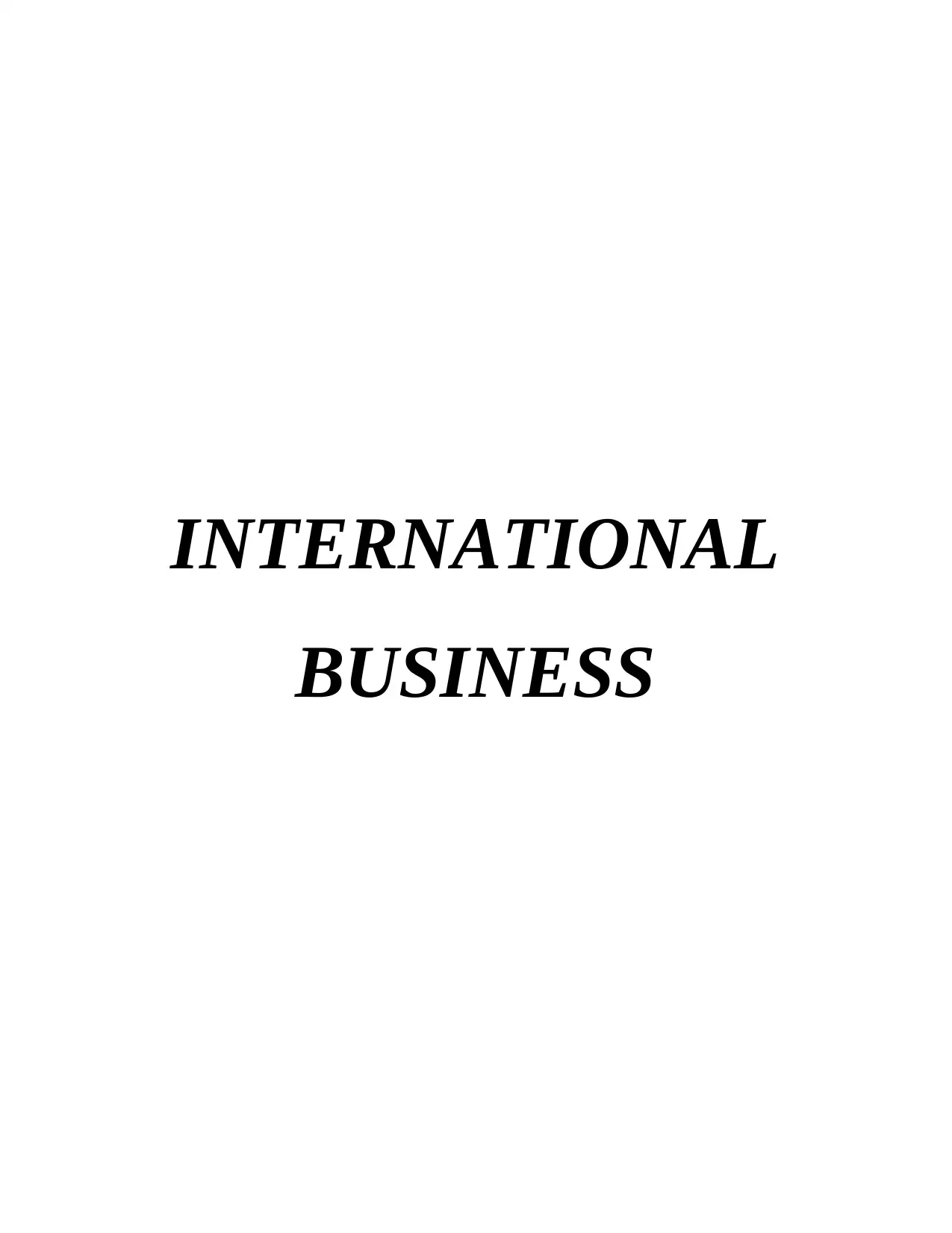
INTERNATIONAL
BUSINESS
BUSINESS
Paraphrase This Document
Need a fresh take? Get an instant paraphrase of this document with our AI Paraphraser
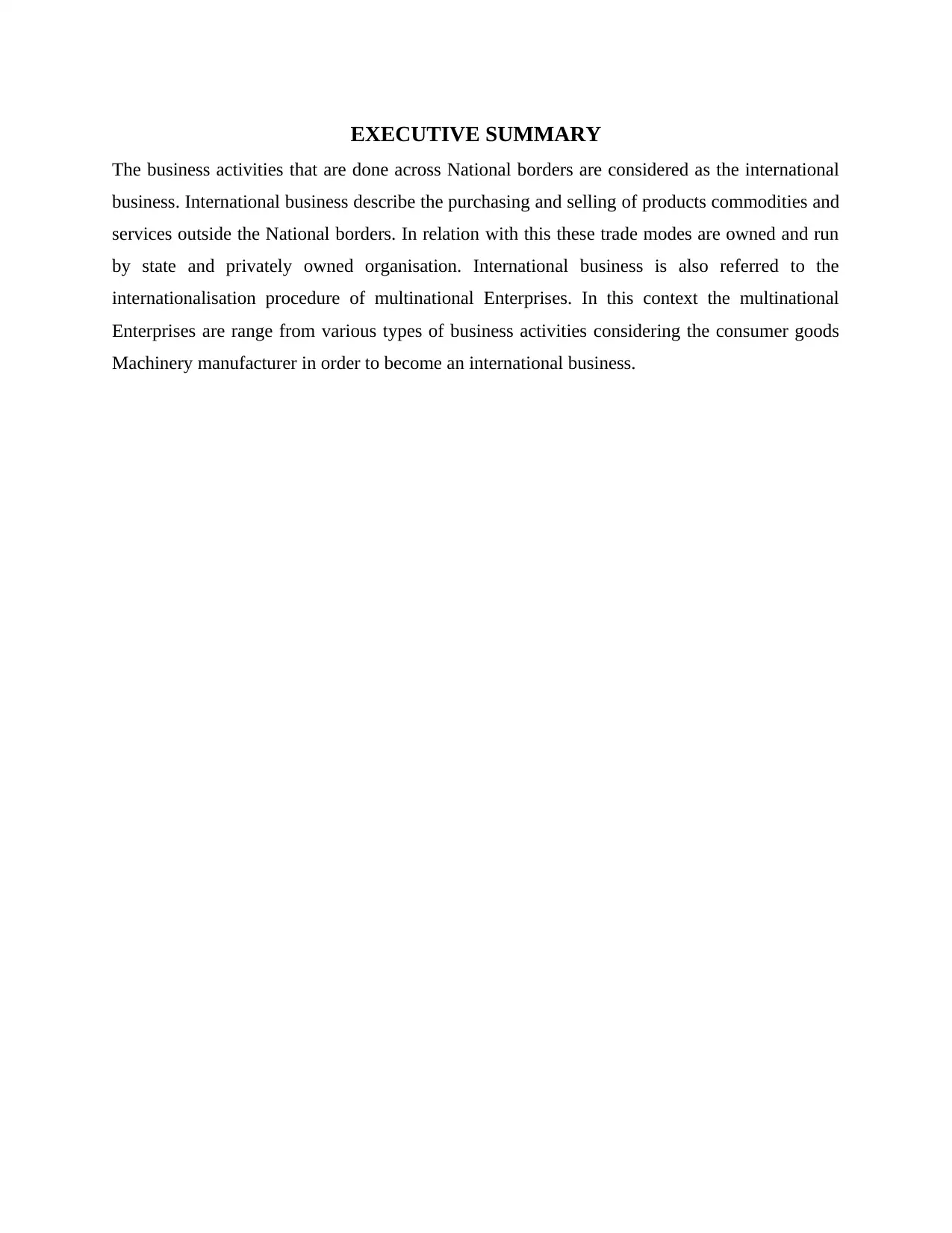
EXECUTIVE SUMMARY
The business activities that are done across National borders are considered as the international
business. International business describe the purchasing and selling of products commodities and
services outside the National borders. In relation with this these trade modes are owned and run
by state and privately owned organisation. International business is also referred to the
internationalisation procedure of multinational Enterprises. In this context the multinational
Enterprises are range from various types of business activities considering the consumer goods
Machinery manufacturer in order to become an international business.
The business activities that are done across National borders are considered as the international
business. International business describe the purchasing and selling of products commodities and
services outside the National borders. In relation with this these trade modes are owned and run
by state and privately owned organisation. International business is also referred to the
internationalisation procedure of multinational Enterprises. In this context the multinational
Enterprises are range from various types of business activities considering the consumer goods
Machinery manufacturer in order to become an international business.
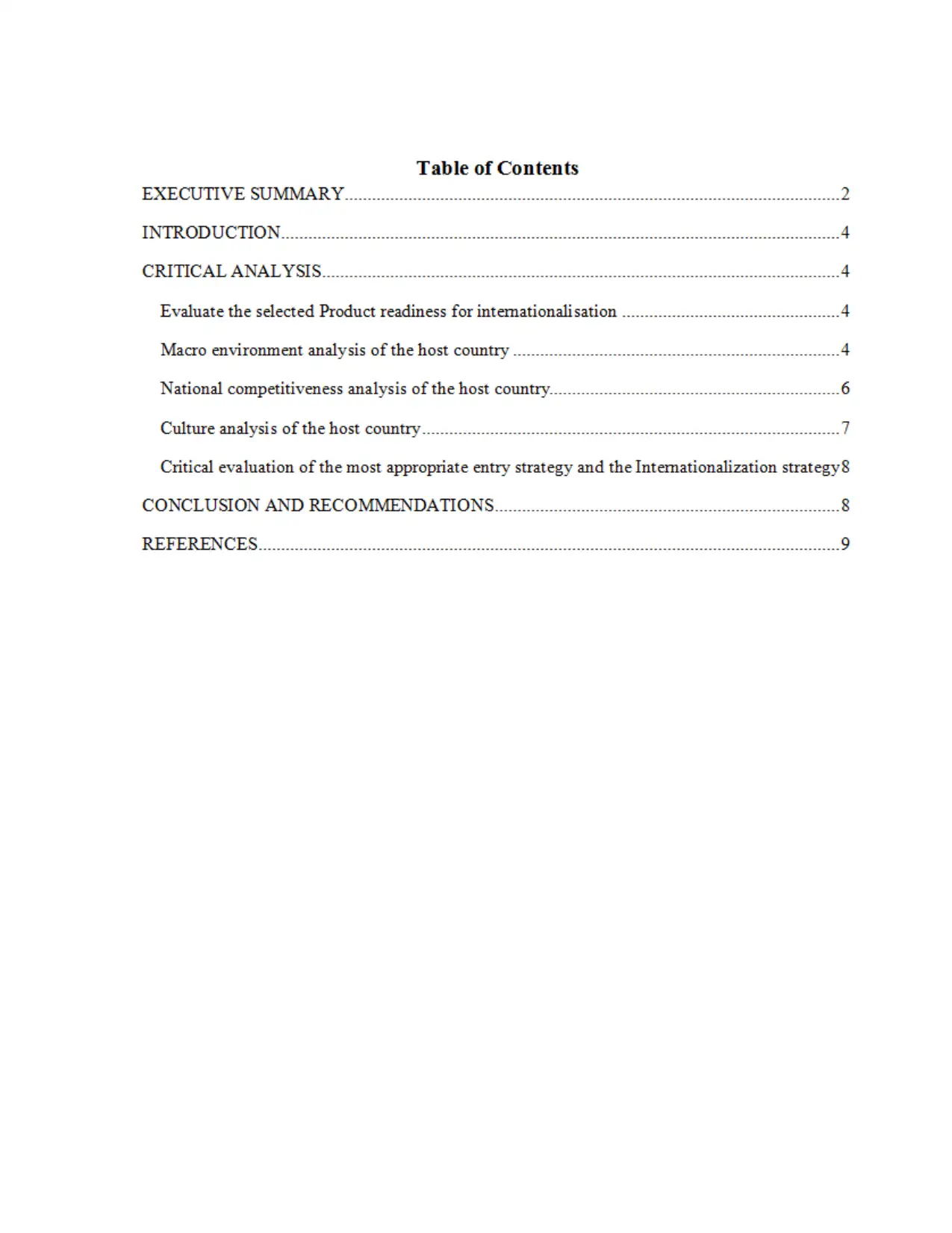
⊘ This is a preview!⊘
Do you want full access?
Subscribe today to unlock all pages.

Trusted by 1+ million students worldwide
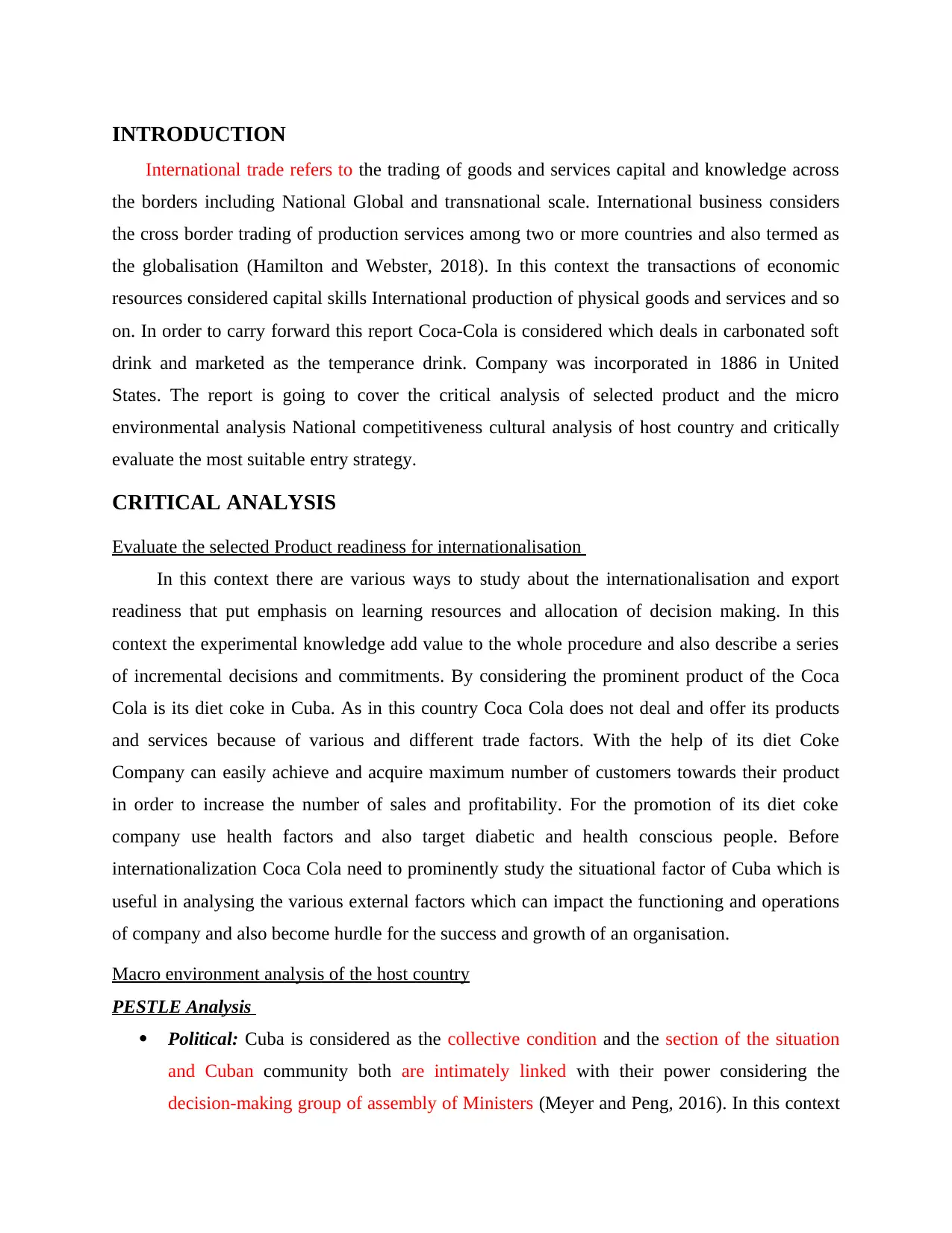
INTRODUCTION
International trade refers to the trading of goods and services capital and knowledge across
the borders including National Global and transnational scale. International business considers
the cross border trading of production services among two or more countries and also termed as
the globalisation (Hamilton and Webster, 2018). In this context the transactions of economic
resources considered capital skills International production of physical goods and services and so
on. In order to carry forward this report Coca-Cola is considered which deals in carbonated soft
drink and marketed as the temperance drink. Company was incorporated in 1886 in United
States. The report is going to cover the critical analysis of selected product and the micro
environmental analysis National competitiveness cultural analysis of host country and critically
evaluate the most suitable entry strategy.
CRITICAL ANALYSIS
Evaluate the selected Product readiness for internationalisation
In this context there are various ways to study about the internationalisation and export
readiness that put emphasis on learning resources and allocation of decision making. In this
context the experimental knowledge add value to the whole procedure and also describe a series
of incremental decisions and commitments. By considering the prominent product of the Coca
Cola is its diet coke in Cuba. As in this country Coca Cola does not deal and offer its products
and services because of various and different trade factors. With the help of its diet Coke
Company can easily achieve and acquire maximum number of customers towards their product
in order to increase the number of sales and profitability. For the promotion of its diet coke
company use health factors and also target diabetic and health conscious people. Before
internationalization Coca Cola need to prominently study the situational factor of Cuba which is
useful in analysing the various external factors which can impact the functioning and operations
of company and also become hurdle for the success and growth of an organisation.
Macro environment analysis of the host country
PESTLE Analysis
Political: Cuba is considered as the collective condition and the section of the situation
and Cuban community both are intimately linked with their power considering the
decision-making group of assembly of Ministers (Meyer and Peng, 2016). In this context
International trade refers to the trading of goods and services capital and knowledge across
the borders including National Global and transnational scale. International business considers
the cross border trading of production services among two or more countries and also termed as
the globalisation (Hamilton and Webster, 2018). In this context the transactions of economic
resources considered capital skills International production of physical goods and services and so
on. In order to carry forward this report Coca-Cola is considered which deals in carbonated soft
drink and marketed as the temperance drink. Company was incorporated in 1886 in United
States. The report is going to cover the critical analysis of selected product and the micro
environmental analysis National competitiveness cultural analysis of host country and critically
evaluate the most suitable entry strategy.
CRITICAL ANALYSIS
Evaluate the selected Product readiness for internationalisation
In this context there are various ways to study about the internationalisation and export
readiness that put emphasis on learning resources and allocation of decision making. In this
context the experimental knowledge add value to the whole procedure and also describe a series
of incremental decisions and commitments. By considering the prominent product of the Coca
Cola is its diet coke in Cuba. As in this country Coca Cola does not deal and offer its products
and services because of various and different trade factors. With the help of its diet Coke
Company can easily achieve and acquire maximum number of customers towards their product
in order to increase the number of sales and profitability. For the promotion of its diet coke
company use health factors and also target diabetic and health conscious people. Before
internationalization Coca Cola need to prominently study the situational factor of Cuba which is
useful in analysing the various external factors which can impact the functioning and operations
of company and also become hurdle for the success and growth of an organisation.
Macro environment analysis of the host country
PESTLE Analysis
Political: Cuba is considered as the collective condition and the section of the situation
and Cuban community both are intimately linked with their power considering the
decision-making group of assembly of Ministers (Meyer and Peng, 2016). In this context
Paraphrase This Document
Need a fresh take? Get an instant paraphrase of this document with our AI Paraphraser
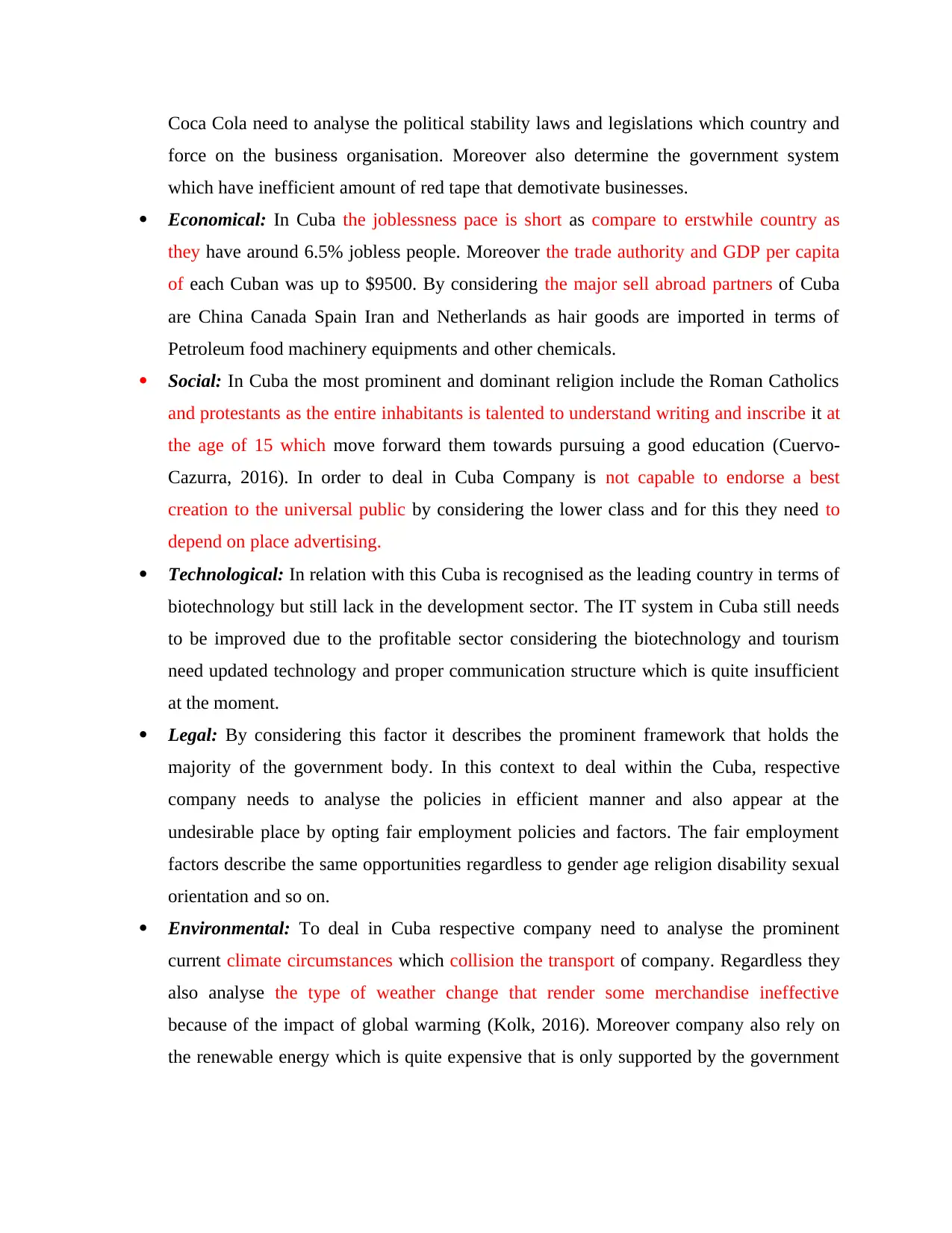
Coca Cola need to analyse the political stability laws and legislations which country and
force on the business organisation. Moreover also determine the government system
which have inefficient amount of red tape that demotivate businesses.
Economical: In Cuba the joblessness pace is short as compare to erstwhile country as
they have around 6.5% jobless people. Moreover the trade authority and GDP per capita
of each Cuban was up to $9500. By considering the major sell abroad partners of Cuba
are China Canada Spain Iran and Netherlands as hair goods are imported in terms of
Petroleum food machinery equipments and other chemicals.
Social: In Cuba the most prominent and dominant religion include the Roman Catholics
and protestants as the entire inhabitants is talented to understand writing and inscribe it at
the age of 15 which move forward them towards pursuing a good education (Cuervo-
Cazurra, 2016). In order to deal in Cuba Company is not capable to endorse a best
creation to the universal public by considering the lower class and for this they need to
depend on place advertising.
Technological: In relation with this Cuba is recognised as the leading country in terms of
biotechnology but still lack in the development sector. The IT system in Cuba still needs
to be improved due to the profitable sector considering the biotechnology and tourism
need updated technology and proper communication structure which is quite insufficient
at the moment.
Legal: By considering this factor it describes the prominent framework that holds the
majority of the government body. In this context to deal within the Cuba, respective
company needs to analyse the policies in efficient manner and also appear at the
undesirable place by opting fair employment policies and factors. The fair employment
factors describe the same opportunities regardless to gender age religion disability sexual
orientation and so on.
Environmental: To deal in Cuba respective company need to analyse the prominent
current climate circumstances which collision the transport of company. Regardless they
also analyse the type of weather change that render some merchandise ineffective
because of the impact of global warming (Kolk, 2016). Moreover company also rely on
the renewable energy which is quite expensive that is only supported by the government
force on the business organisation. Moreover also determine the government system
which have inefficient amount of red tape that demotivate businesses.
Economical: In Cuba the joblessness pace is short as compare to erstwhile country as
they have around 6.5% jobless people. Moreover the trade authority and GDP per capita
of each Cuban was up to $9500. By considering the major sell abroad partners of Cuba
are China Canada Spain Iran and Netherlands as hair goods are imported in terms of
Petroleum food machinery equipments and other chemicals.
Social: In Cuba the most prominent and dominant religion include the Roman Catholics
and protestants as the entire inhabitants is talented to understand writing and inscribe it at
the age of 15 which move forward them towards pursuing a good education (Cuervo-
Cazurra, 2016). In order to deal in Cuba Company is not capable to endorse a best
creation to the universal public by considering the lower class and for this they need to
depend on place advertising.
Technological: In relation with this Cuba is recognised as the leading country in terms of
biotechnology but still lack in the development sector. The IT system in Cuba still needs
to be improved due to the profitable sector considering the biotechnology and tourism
need updated technology and proper communication structure which is quite insufficient
at the moment.
Legal: By considering this factor it describes the prominent framework that holds the
majority of the government body. In this context to deal within the Cuba, respective
company needs to analyse the policies in efficient manner and also appear at the
undesirable place by opting fair employment policies and factors. The fair employment
factors describe the same opportunities regardless to gender age religion disability sexual
orientation and so on.
Environmental: To deal in Cuba respective company need to analyse the prominent
current climate circumstances which collision the transport of company. Regardless they
also analyse the type of weather change that render some merchandise ineffective
because of the impact of global warming (Kolk, 2016). Moreover company also rely on
the renewable energy which is quite expensive that is only supported by the government
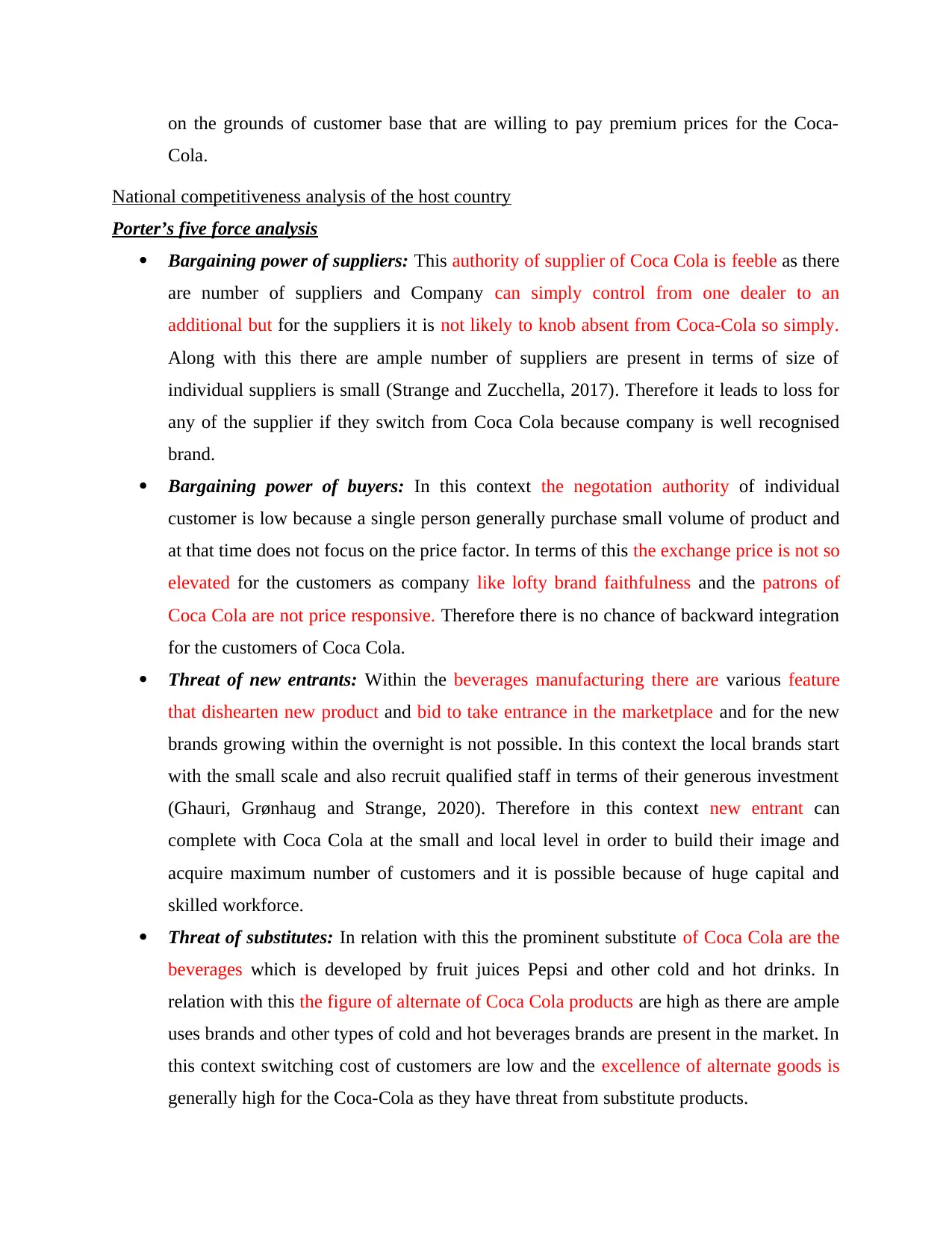
on the grounds of customer base that are willing to pay premium prices for the Coca-
Cola.
National competitiveness analysis of the host country
Porter’s five force analysis
Bargaining power of suppliers: This authority of supplier of Coca Cola is feeble as there
are number of suppliers and Company can simply control from one dealer to an
additional but for the suppliers it is not likely to knob absent from Coca-Cola so simply.
Along with this there are ample number of suppliers are present in terms of size of
individual suppliers is small (Strange and Zucchella, 2017). Therefore it leads to loss for
any of the supplier if they switch from Coca Cola because company is well recognised
brand.
Bargaining power of buyers: In this context the negotation authority of individual
customer is low because a single person generally purchase small volume of product and
at that time does not focus on the price factor. In terms of this the exchange price is not so
elevated for the customers as company like lofty brand faithfulness and the patrons of
Coca Cola are not price responsive. Therefore there is no chance of backward integration
for the customers of Coca Cola.
Threat of new entrants: Within the beverages manufacturing there are various feature
that dishearten new product and bid to take entrance in the marketplace and for the new
brands growing within the overnight is not possible. In this context the local brands start
with the small scale and also recruit qualified staff in terms of their generous investment
(Ghauri, Grønhaug and Strange, 2020). Therefore in this context new entrant can
complete with Coca Cola at the small and local level in order to build their image and
acquire maximum number of customers and it is possible because of huge capital and
skilled workforce.
Threat of substitutes: In relation with this the prominent substitute of Coca Cola are the
beverages which is developed by fruit juices Pepsi and other cold and hot drinks. In
relation with this the figure of alternate of Coca Cola products are high as there are ample
uses brands and other types of cold and hot beverages brands are present in the market. In
this context switching cost of customers are low and the excellence of alternate goods is
generally high for the Coca-Cola as they have threat from substitute products.
Cola.
National competitiveness analysis of the host country
Porter’s five force analysis
Bargaining power of suppliers: This authority of supplier of Coca Cola is feeble as there
are number of suppliers and Company can simply control from one dealer to an
additional but for the suppliers it is not likely to knob absent from Coca-Cola so simply.
Along with this there are ample number of suppliers are present in terms of size of
individual suppliers is small (Strange and Zucchella, 2017). Therefore it leads to loss for
any of the supplier if they switch from Coca Cola because company is well recognised
brand.
Bargaining power of buyers: In this context the negotation authority of individual
customer is low because a single person generally purchase small volume of product and
at that time does not focus on the price factor. In terms of this the exchange price is not so
elevated for the customers as company like lofty brand faithfulness and the patrons of
Coca Cola are not price responsive. Therefore there is no chance of backward integration
for the customers of Coca Cola.
Threat of new entrants: Within the beverages manufacturing there are various feature
that dishearten new product and bid to take entrance in the marketplace and for the new
brands growing within the overnight is not possible. In this context the local brands start
with the small scale and also recruit qualified staff in terms of their generous investment
(Ghauri, Grønhaug and Strange, 2020). Therefore in this context new entrant can
complete with Coca Cola at the small and local level in order to build their image and
acquire maximum number of customers and it is possible because of huge capital and
skilled workforce.
Threat of substitutes: In relation with this the prominent substitute of Coca Cola are the
beverages which is developed by fruit juices Pepsi and other cold and hot drinks. In
relation with this the figure of alternate of Coca Cola products are high as there are ample
uses brands and other types of cold and hot beverages brands are present in the market. In
this context switching cost of customers are low and the excellence of alternate goods is
generally high for the Coca-Cola as they have threat from substitute products.
⊘ This is a preview!⊘
Do you want full access?
Subscribe today to unlock all pages.

Trusted by 1+ million students worldwide
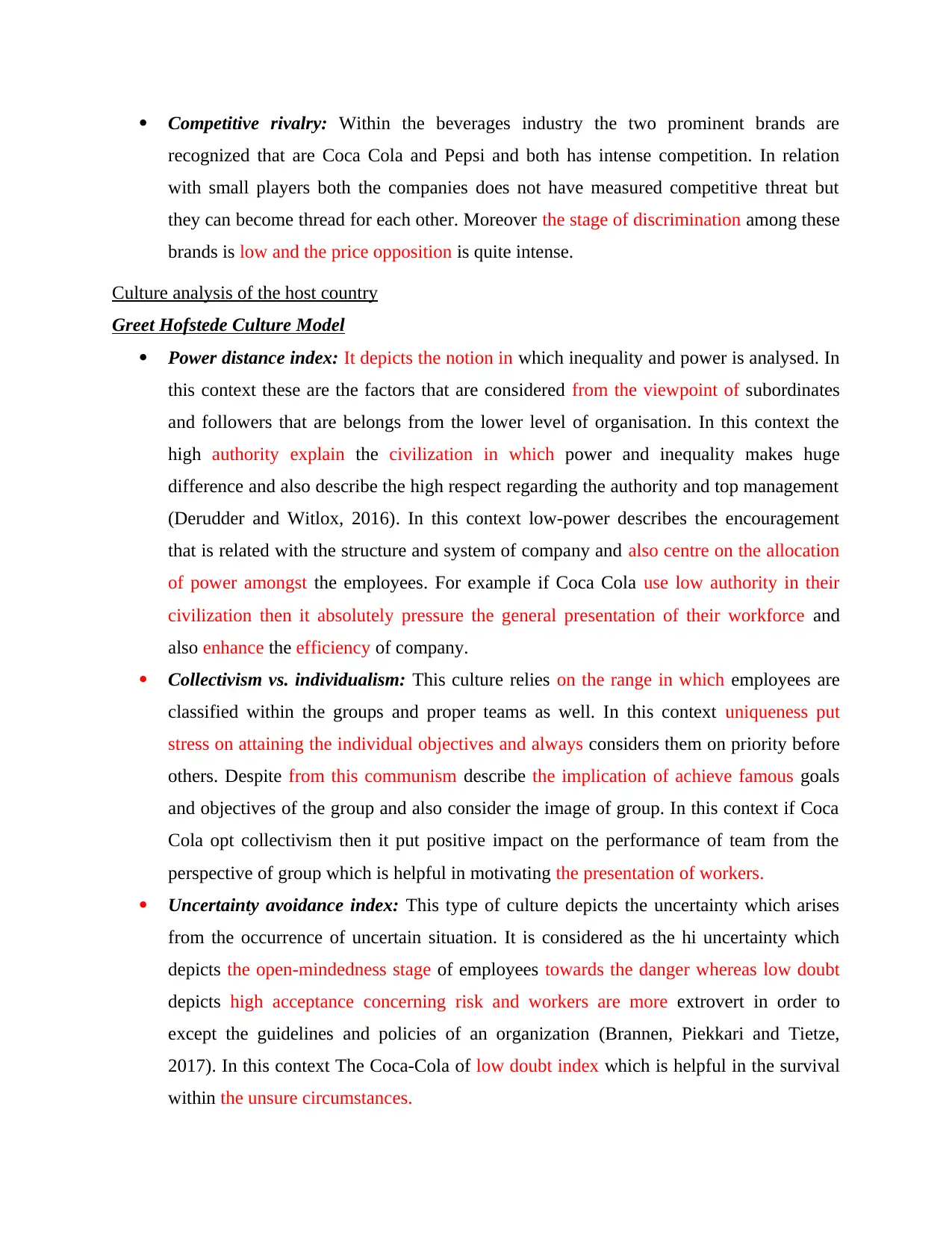
Competitive rivalry: Within the beverages industry the two prominent brands are
recognized that are Coca Cola and Pepsi and both has intense competition. In relation
with small players both the companies does not have measured competitive threat but
they can become thread for each other. Moreover the stage of discrimination among these
brands is low and the price opposition is quite intense.
Culture analysis of the host country
Greet Hofstede Culture Model
Power distance index: It depicts the notion in which inequality and power is analysed. In
this context these are the factors that are considered from the viewpoint of subordinates
and followers that are belongs from the lower level of organisation. In this context the
high authority explain the civilization in which power and inequality makes huge
difference and also describe the high respect regarding the authority and top management
(Derudder and Witlox, 2016). In this context low-power describes the encouragement
that is related with the structure and system of company and also centre on the allocation
of power amongst the employees. For example if Coca Cola use low authority in their
civilization then it absolutely pressure the general presentation of their workforce and
also enhance the efficiency of company.
Collectivism vs. individualism: This culture relies on the range in which employees are
classified within the groups and proper teams as well. In this context uniqueness put
stress on attaining the individual objectives and always considers them on priority before
others. Despite from this communism describe the implication of achieve famous goals
and objectives of the group and also consider the image of group. In this context if Coca
Cola opt collectivism then it put positive impact on the performance of team from the
perspective of group which is helpful in motivating the presentation of workers.
Uncertainty avoidance index: This type of culture depicts the uncertainty which arises
from the occurrence of uncertain situation. It is considered as the hi uncertainty which
depicts the open-mindedness stage of employees towards the danger whereas low doubt
depicts high acceptance concerning risk and workers are more extrovert in order to
except the guidelines and policies of an organization (Brannen, Piekkari and Tietze,
2017). In this context The Coca-Cola of low doubt index which is helpful in the survival
within the unsure circumstances.
recognized that are Coca Cola and Pepsi and both has intense competition. In relation
with small players both the companies does not have measured competitive threat but
they can become thread for each other. Moreover the stage of discrimination among these
brands is low and the price opposition is quite intense.
Culture analysis of the host country
Greet Hofstede Culture Model
Power distance index: It depicts the notion in which inequality and power is analysed. In
this context these are the factors that are considered from the viewpoint of subordinates
and followers that are belongs from the lower level of organisation. In this context the
high authority explain the civilization in which power and inequality makes huge
difference and also describe the high respect regarding the authority and top management
(Derudder and Witlox, 2016). In this context low-power describes the encouragement
that is related with the structure and system of company and also centre on the allocation
of power amongst the employees. For example if Coca Cola use low authority in their
civilization then it absolutely pressure the general presentation of their workforce and
also enhance the efficiency of company.
Collectivism vs. individualism: This culture relies on the range in which employees are
classified within the groups and proper teams as well. In this context uniqueness put
stress on attaining the individual objectives and always considers them on priority before
others. Despite from this communism describe the implication of achieve famous goals
and objectives of the group and also consider the image of group. In this context if Coca
Cola opt collectivism then it put positive impact on the performance of team from the
perspective of group which is helpful in motivating the presentation of workers.
Uncertainty avoidance index: This type of culture depicts the uncertainty which arises
from the occurrence of uncertain situation. It is considered as the hi uncertainty which
depicts the open-mindedness stage of employees towards the danger whereas low doubt
depicts high acceptance concerning risk and workers are more extrovert in order to
except the guidelines and policies of an organization (Brannen, Piekkari and Tietze,
2017). In this context The Coca-Cola of low doubt index which is helpful in the survival
within the unsure circumstances.
Paraphrase This Document
Need a fresh take? Get an instant paraphrase of this document with our AI Paraphraser
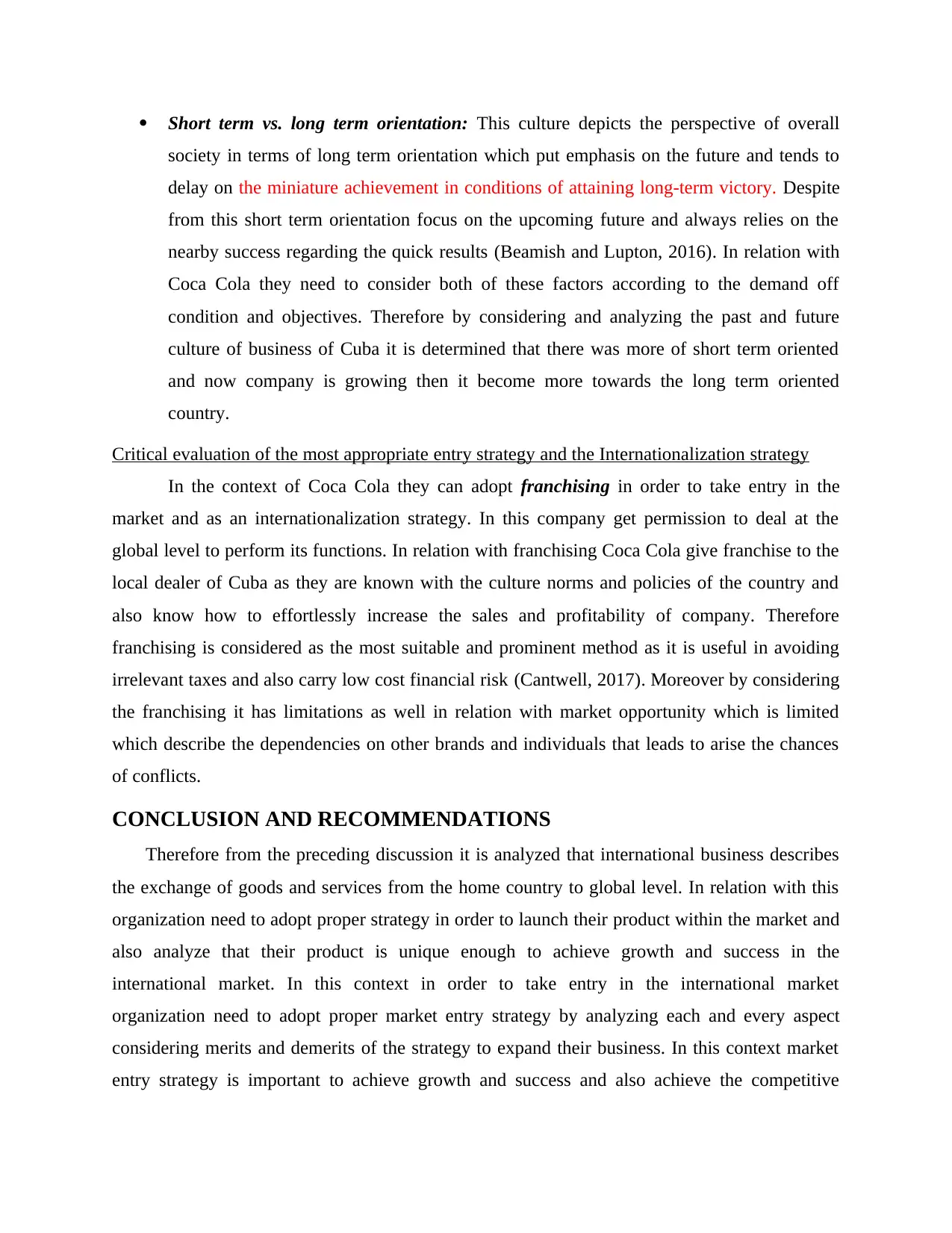
Short term vs. long term orientation: This culture depicts the perspective of overall
society in terms of long term orientation which put emphasis on the future and tends to
delay on the miniature achievement in conditions of attaining long-term victory. Despite
from this short term orientation focus on the upcoming future and always relies on the
nearby success regarding the quick results (Beamish and Lupton, 2016). In relation with
Coca Cola they need to consider both of these factors according to the demand off
condition and objectives. Therefore by considering and analyzing the past and future
culture of business of Cuba it is determined that there was more of short term oriented
and now company is growing then it become more towards the long term oriented
country.
Critical evaluation of the most appropriate entry strategy and the Internationalization strategy
In the context of Coca Cola they can adopt franchising in order to take entry in the
market and as an internationalization strategy. In this company get permission to deal at the
global level to perform its functions. In relation with franchising Coca Cola give franchise to the
local dealer of Cuba as they are known with the culture norms and policies of the country and
also know how to effortlessly increase the sales and profitability of company. Therefore
franchising is considered as the most suitable and prominent method as it is useful in avoiding
irrelevant taxes and also carry low cost financial risk (Cantwell, 2017). Moreover by considering
the franchising it has limitations as well in relation with market opportunity which is limited
which describe the dependencies on other brands and individuals that leads to arise the chances
of conflicts.
CONCLUSION AND RECOMMENDATIONS
Therefore from the preceding discussion it is analyzed that international business describes
the exchange of goods and services from the home country to global level. In relation with this
organization need to adopt proper strategy in order to launch their product within the market and
also analyze that their product is unique enough to achieve growth and success in the
international market. In this context in order to take entry in the international market
organization need to adopt proper market entry strategy by analyzing each and every aspect
considering merits and demerits of the strategy to expand their business. In this context market
entry strategy is important to achieve growth and success and also achieve the competitive
society in terms of long term orientation which put emphasis on the future and tends to
delay on the miniature achievement in conditions of attaining long-term victory. Despite
from this short term orientation focus on the upcoming future and always relies on the
nearby success regarding the quick results (Beamish and Lupton, 2016). In relation with
Coca Cola they need to consider both of these factors according to the demand off
condition and objectives. Therefore by considering and analyzing the past and future
culture of business of Cuba it is determined that there was more of short term oriented
and now company is growing then it become more towards the long term oriented
country.
Critical evaluation of the most appropriate entry strategy and the Internationalization strategy
In the context of Coca Cola they can adopt franchising in order to take entry in the
market and as an internationalization strategy. In this company get permission to deal at the
global level to perform its functions. In relation with franchising Coca Cola give franchise to the
local dealer of Cuba as they are known with the culture norms and policies of the country and
also know how to effortlessly increase the sales and profitability of company. Therefore
franchising is considered as the most suitable and prominent method as it is useful in avoiding
irrelevant taxes and also carry low cost financial risk (Cantwell, 2017). Moreover by considering
the franchising it has limitations as well in relation with market opportunity which is limited
which describe the dependencies on other brands and individuals that leads to arise the chances
of conflicts.
CONCLUSION AND RECOMMENDATIONS
Therefore from the preceding discussion it is analyzed that international business describes
the exchange of goods and services from the home country to global level. In relation with this
organization need to adopt proper strategy in order to launch their product within the market and
also analyze that their product is unique enough to achieve growth and success in the
international market. In this context in order to take entry in the international market
organization need to adopt proper market entry strategy by analyzing each and every aspect
considering merits and demerits of the strategy to expand their business. In this context market
entry strategy is important to achieve growth and success and also achieve the competitive
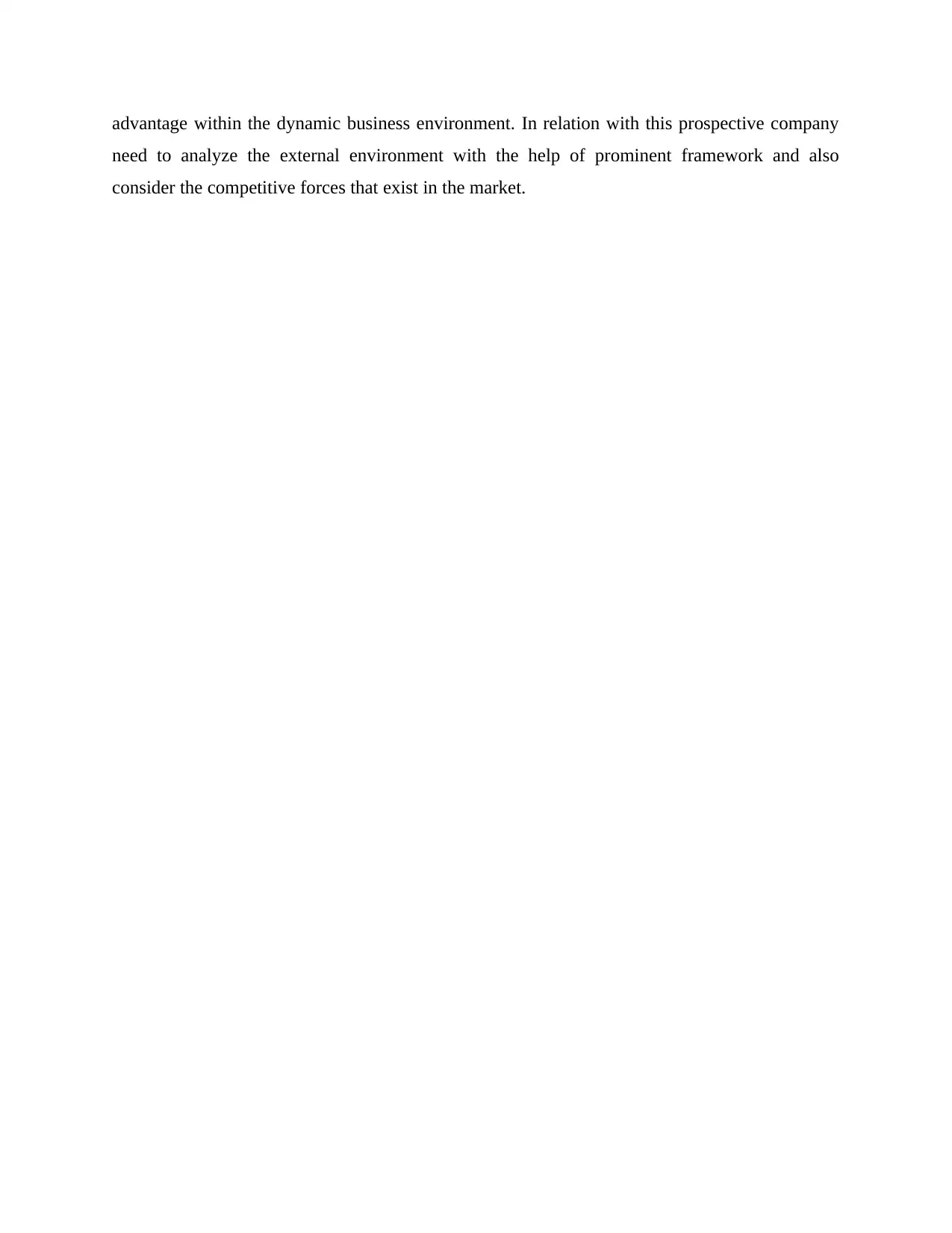
advantage within the dynamic business environment. In relation with this prospective company
need to analyze the external environment with the help of prominent framework and also
consider the competitive forces that exist in the market.
need to analyze the external environment with the help of prominent framework and also
consider the competitive forces that exist in the market.
⊘ This is a preview!⊘
Do you want full access?
Subscribe today to unlock all pages.

Trusted by 1+ million students worldwide
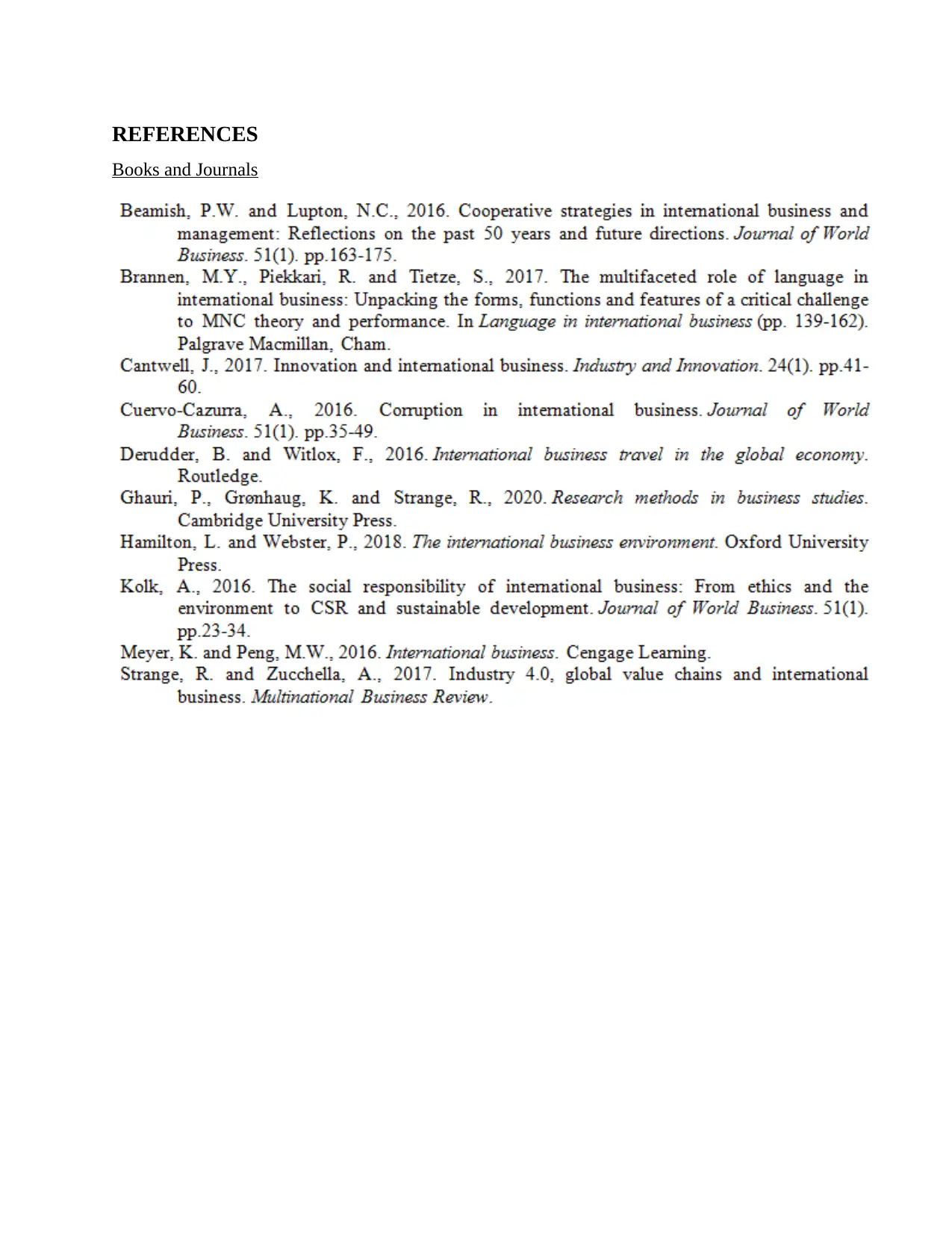
REFERENCES
Books and Journals
Books and Journals
1 out of 10
Related Documents
Your All-in-One AI-Powered Toolkit for Academic Success.
+13062052269
info@desklib.com
Available 24*7 on WhatsApp / Email
![[object Object]](/_next/static/media/star-bottom.7253800d.svg)
Unlock your academic potential
Copyright © 2020–2025 A2Z Services. All Rights Reserved. Developed and managed by ZUCOL.





